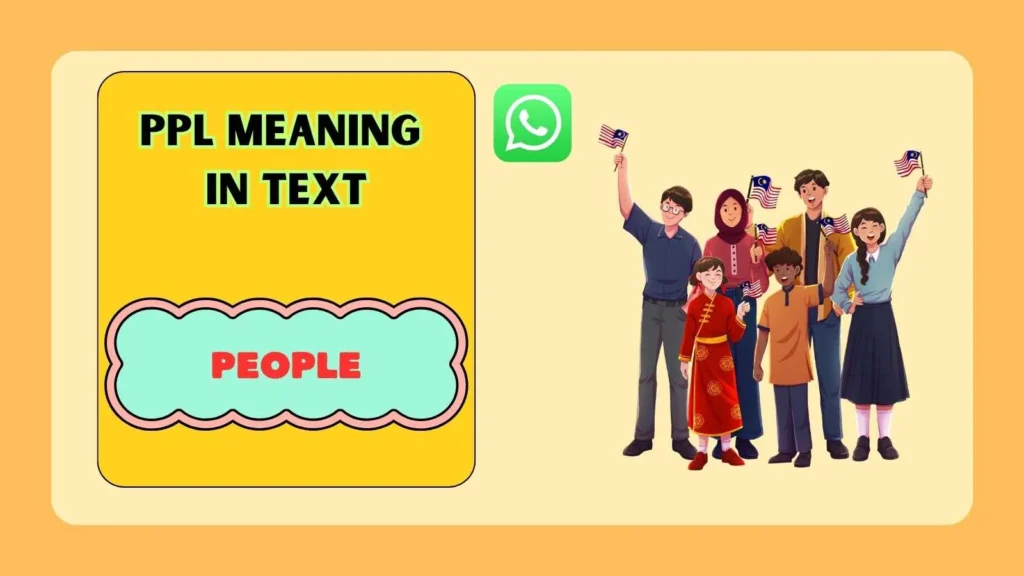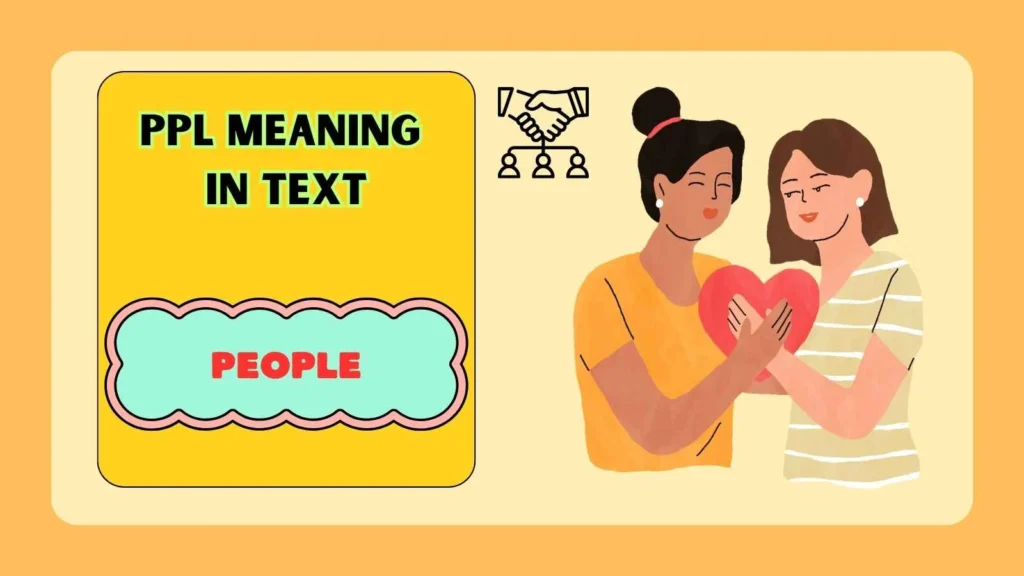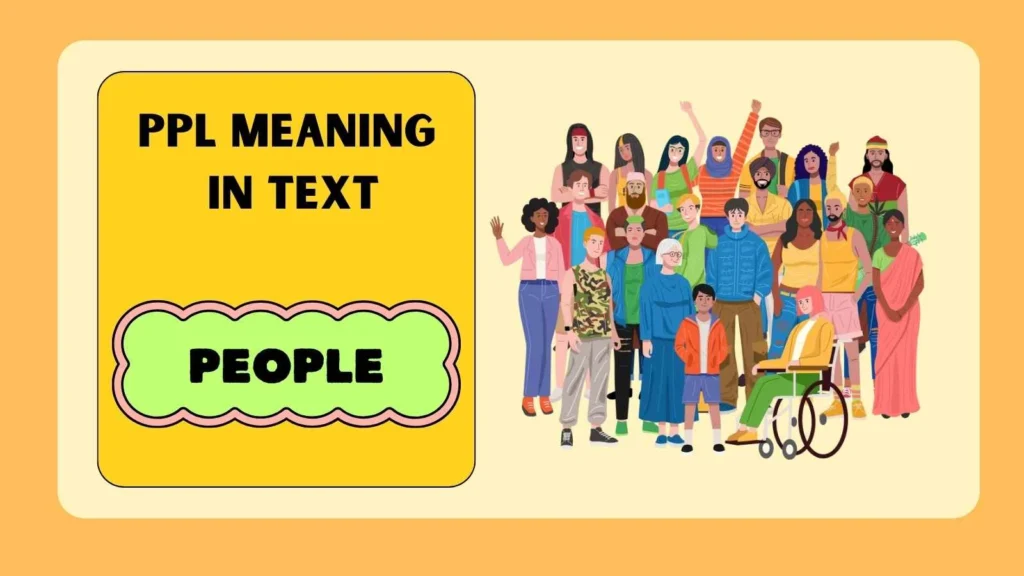Last updated on November 2nd, 2025 at 10:37 pm
Ever scrolled through a text or social media message and stumbled upon PPL? Wondering what it actually means in your chats? You’re not alone.
PPL Meaning in Text has become one of the most trending acronyms among Gen Z and Millennials, and knowing it can make your texting sharper, faster, and more fun.
From casual conversations to social media banter, understanding this simple abbreviation gives you a secret edge, keeps you in-the-know, and helps you stay relevant in digital conversations.
Don’t miss out discover the real meaning, its common usage, and why everyone is talking about PPL today. Power up your texting game with this ultimate guide.
Definition & Meaning
PPL is a widely used shorthand in digital communication, primarily standing for “people”. It simplifies texting by replacing a full word with an easy-to-type abbreviation, saving time in casual conversations.
While it most often refers to a group of people, its meaning can vary slightly depending on context. For instance, someone might say, “I met some cool PPL at the concert,” meaning “people.”
The abbreviation is primarily informal and popular among teenagers, young adults, and social media users. It’s rarely used in formal writing but is highly effective for quick messaging, social posts, or chats where brevity matters.
Background & History
The emergence of acronyms like PPL is closely tied to the rise of SMS texting and instant messaging in the early 2000s. Limited character counts and the need for speed encouraged users to develop abbreviations for common words. Texting culture, followed by social media platforms like Facebook, Twitter, and Instagram, cemented PPL as a standard shorthand for “people.”
Interestingly, PPL also appears in online gaming, forums, and messaging apps, showing how language evolves with technology. This abbreviation represents a modern linguistic trend where efficiency and brevity outweigh traditional spelling rules.
Usage in Various Contexts
PPL is versatile and context-dependent:
- Casual Texting: “PPL are gathering at the park.”
- Social Media Posts: “So many amazing PPL at the event today!”
- Online Forums: Used to discuss groups, communities, or audiences.
- Dating Apps: Indicates the type of social or group settings someone prefers.
Despite its simplicity, knowing the context is key, as PPL might not always clearly convey the intended nuance without surrounding words.
Common Misconceptions & Clarifications
A common misunderstanding is that PPL might stand for complicated phrases like “Public Private Link” or technical terms in professional settings. However, in everyday texting and social media, it almost exclusively refers to “people.”
Another misconception is that using abbreviations like PPL is unprofessional. While informal texting is suitable for friends and social media, professionals are advised to use full words in business communication to avoid confusion or misinterpretation.
Similar Terms & Alternatives
Some alternatives or similar abbreviations include:
- folks – casual synonym for people
- peeps – informal and friendly
- guys – common in group references
- everyone – broader, more formal
Each alternative has subtle differences in tone and context, so choosing the right one ensures your message is interpreted correctly.
How to Respond to This Term
Responding to PPL is straightforward. Since it’s simply a reference to people, replies depend on the conversation:
- Agreeing or acknowledging: “Yeah, I met some cool PPL too.”
- Adding information: “The PPL at the event were really welcoming.”
- Asking for clarification: “Which PPL are you referring to?”
Using PPL in replies maintains consistency and keeps communication casual and efficient.
Regional or Cultural Differences
While PPL is widely recognized in English-speaking countries, some regions may prefer peeps or just “people” spelled out.
Cultural context also affects its tone; in some circles, abbreviations are casual and friendly, while in others, they may seem too informal.
Online communities often set the standard for such language trends, influencing how widely PPL is adopted globally.
Comparison with Similar Terms
Compared to alternatives like folks, peeps, or guys, PPL is strictly digital. It emphasizes speed and text efficiency, making it less suitable for spoken conversations. In contrast, “folks” or “guys” is more natural in speech.
This distinction highlights how language adapts differently for texting versus in-person communication.
Usage in Online Communities & Dating Apps
Online communities love PPL for its brevity. Gaming groups, forums, and social platforms frequently use it to discuss audiences or participants. On dating apps, it’s often seen in bios or messages:
- “Looking to meet fun PPL around town.”
- “Good vibes only, no toxic PPL.”
It communicates social preferences quickly while keeping messages short and readable.
Hidden or Offensive Meanings
Generally, PPL is neutral and harmless. However, in rare cases, some users may use abbreviations sarcastically or negatively: “Ugh, some PPL are so annoying.” Understanding tone and context is key to avoiding misinterpretation.
Suitability for Professional Communication
In professional emails, reports, or meetings, using PPL is not recommended. It’s informal and may appear unpolished. For workplace communication, writing “people” fully ensures clarity, professionalism, and proper tone.
💬 PPL Means in WhatsApp

- 📱 PPL stands for “People” — one of the most common texting abbreviations.
- 💡 It saves time when chatting in groups or quick messages.
- ⚡ Users prefer it for fast replies and casual tone.
- 🧠 On WhatsApp, PPL is a universal shortcut for group references.
- ✨ It’s often used in sentences like “PPL are coming” or “Nice PPL here.”
- 😎 Keeps chats friendly, light, and less formal.
- 💬 You’ll spot it in both personal and community group chats.
- 🔥 Perfect for informal digital communication and daily texting.
- 🌍 Common among Gen Z and Millennials for effortless typing.
- 💬 Overall, PPL makes WhatsApp chats smoother and quicker.
💼 PPL Meaning in Business
- 💡 In business, PPL can mean “Pay Per Lead”, a marketing term.
- 📊 It’s used in digital marketing and advertising strategies.
- ⚡ Refers to paying only when a qualified lead is generated.
- 💼 Businesses use PPL models to boost ROI and reduce ad waste.
- 📈 Common on platforms like Google Ads, Facebook, and LinkedIn.
- 🧠 Also seen in affiliate marketing and performance-based campaigns.
- 💬 It ensures companies pay for results, not random clicks.
- 🧩 Sometimes, it’s confused with “Pay Per Link” — but that’s different.
- 🔎 PPL marketing focuses on quality customer acquisition.
- 🚀 Overall, PPL helps businesses maximize conversions efficiently.
😂 PPL Meaning in Text (Funny)
- 🤣 In funny chats, PPL = People, used jokingly or sarcastically.
- 💬 Example: “PPL these days 😂” — teasing or playful tone.
- 😜 It adds humor and lightness to casual texting.
- ⚡ Often paired with emojis to exaggerate the joke.
- 😂 Used to express collective amusement or mild frustration.
- 🧠 It’s popular in memes, group chats, and funny comment sections.
- 🌍 Common on TikTok, Instagram, and Snapchat.
- 💬 PPL gives a relatable, meme-worthy vibe to messages.
- 💞 Helps express shared humor with minimal words.
- 🎉 Overall, it’s a fun, expressive slang for everyday laughter.
❤️ PPL Meaning in Relationship

- 💞 In relationships, PPL usually refers to “People” in a romantic context.
- 💬 Example: “Some PPL just don’t get it 😅” — about dating behavior.
- 🧠 Used to describe general attitudes toward love or couples.
- 💡 Sometimes playfully used between partners in casual chats.
- 💌 Adds a light, teasing tone to romantic texting.
- ❤️ It’s informal, making conversations feel natural and relaxed.
- 💬 “PPL be acting different when they’re in love 💘” — popular meme use.
- 😎 Great for expressing shared thoughts or relationship humor.
- 💞 Builds connection through everyday language and simplicity.
- 🌟 Overall, PPL keeps relationship talks fun, modern, and relatable.
FAQs
What does PPL stand for in texting?
It stands for people.
Is PPL slang or formal?
It’s informal slang, mainly for texting and social media.
Can I use PPL at work?
It’s not recommended in professional contexts.
Is PPL used globally?
Yes, but some regions prefer alternatives like peeps or full words.
Are there offensive meanings for PPL?
Generally no, but tone can make it negative.
How do I reply to PPL in a message?
Acknowledge or add context: “Yeah, the PPL were great!”
Conclusion
PPL meaning in text is a simple yet powerful abbreviation representing “people.” Its popularity stems from texting culture, social media trends, and the need for concise communication.
While it’s widely used among young adults, social media users, and online communities, it’s best avoided in professional settings.
Understanding PPL ensures smoother conversations, reduces misunderstandings, and helps you navigate the fast evolving world of digital communication with confidence.
